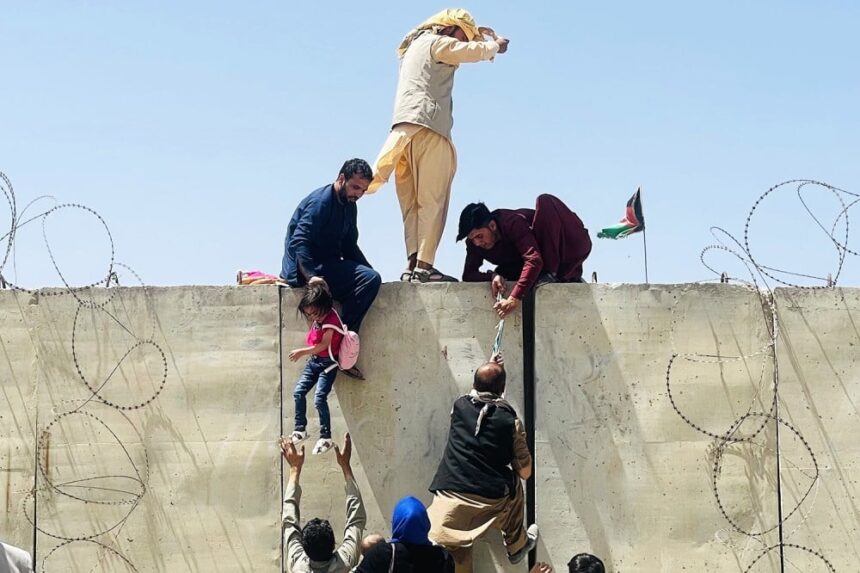The Foreign Policy article examines the U.S.’s diplomatic failures during the Afghanistan war and the missed opportunity for early peace negotiations with the Taliban. After the U.S. invasion in December 2001, the Taliban offered to surrender under conditions of dignified treatment, but the U.S. did not respond, focusing instead on military action and the subsequent invasion of Iraq. This decision contributed to prolonged conflict and a failed peace process.
The Bonn Conference, held to create a new Afghan political order, excluded the Taliban, worsening divisions and fueling their resurgence. Over time, despite attempts by Norway and other actors to mediate, U.S. efforts were hindered by internal disagreements and a lack of cohesive strategy. The eventual Doha Accord, negotiated during the Trump administration, prioritized U.S. withdrawal over a comprehensive peace settlement, leading to the Taliban’s return to power in 2021.
The article highlights the disconnect between military objectives and diplomatic efforts, and the resulting impact on Afghan society, particularly women’s rights and education. The U.S. experience in Afghanistan is seen as a lesson in the limitations of military force and the importance of timely and effective diplomacy.
Read more below.
How Negotiators Failed for Two Decades to Bring Peace to Afghanistan
Of the many missteps the United States made in its two-decade war in Afghanistan, one of the early ones involved a missed opportunity with the Taliban. In December 2001, just weeks after the U.S. invasion of Afghanistan, the Taliban made an offer to the Bush administration: Its fighters would be willing to lay down their arms, provided they could live “in dignity” in their homes without being pursued and detained.
Listen to Season 4 of The Negotiators: The Afghan Impasse, with reporting by Soraya Lennie, Andrew North, Sebastian Walker, Ali Latifi, Shirin Jaafari, and Ashley Jackson.
The offer was made in the form of a message to Afghan political leader Hamid Karzai. Had it been accepted, it may have prevented years of bloodshed and a long American occupation that ended in ignominy. But the United States at the time was reeling from the attacks of 9/11 and determined to eviscerate the group that had hosted al Qaeda leader Osama bin Laden and refused to hand him over. U.S. officials did not even respond to the offer.
Zalmay Khalilzad, a U.S. diplomat who dealt with Afghanistan for years, had a chance to ask the Taliban about that early truce offer while negotiating with the group much later—in 2021. He was struck by the response. “They thought that 20 years of war and all the loss of life on all sides was due to that mistake, as they saw it.”
This week marks three years since the Taliban marched on Kabul and regained control of Afghanistan. The hasty American retreat—and specifically the scenes of chaos at the Kabul airport—stand as a foreign-policy debacle for the Biden administration.
But America’s failure in Afghanistan is a much longer story. To try to understand it, Foreign Policy set out to explore why for two decades some of the world’s most experienced negotiators failed to reach an agreement that would have brought lasting peace to the country. The result of the reporting is a seven-episode season of our podcast, The Negotiators, produced in partnership with Doha Debates, and including interviews with key U.S., Afghan, and Taliban figures. You can hear it on our website or on any of the podcast platforms.
Based on conversations with the main actors, it is a story of misunderstandings, missed opportunities, and complacency—coupled with an American predilection for military action over diplomacy following the shock of 9/11. And while the Taliban were no pacifists themselves, they did at least show an early readiness to negotiate.
The misunderstandings and missed opportunities began to stack up in the closing stages of the U.S. invasion, when the Bush administration had the Taliban on the run and its focus was starting to shift toward Iraq. Uninterested in what it called “nation-building,” the administration asked the United Nations to shoulder the task of creating a new political order.
The result was a hastily convened conference in December 2001 in the German city of Bonn, which anointed Karzai as the new interim leader. But in line with U.S. wishes, the Taliban were excluded from the cross-section of Afghan political groups invited to attend.
For the U.N. and most of the Afghan delegates, the meeting was an opportunity to launch a peace process that would end the country’s forever war—which had been underway since the Soviet invasion in the late 1970s.
But for the Bush administration, the Bonn conference was simply a means “to consolidate victory in the war on terror,” according to American political scientist Barnett Rubin, who was then advising the U.N. envoy in charge of the meeting. “You can look through all the statements of all U.S. officials,” he said. “You will not find a word about peace in Afghanistan.”
That new order, agreed upon at the Bonn conference, did include plans for elections and a new constitution enshrining—among other things—rights for women. It also ushered in a period of optimism in Afghanistan, with millions of Afghan exiles returning home over the next few years, hopeful at that point that their country was on a path to stability with the West’s support.
But the Bonn agreement, patched together quickly, ended up cementing old divisions and creating new ones. “The underlying political issues were not even articulated at Bonn, let alone resolved,” Rubin said. It led directly to the Taliban taking up arms again, aided by the group’s sponsors in neighboring Pakistan, who also felt sidelined.
In response, the United States doubled down on its counterterrorism goal of trying to destroy the Taliban. Even figures who had been trying to maintain a dialogue were arrested, such as the Taliban’s former ambassador to Pakistan, Mullah Abdul Salam Zaeef.
In the years that followed, a weak, fractured, and aid-dependent Afghan government would struggle as the Taliban’s insurgency expanded. Their support grew as the death toll from U.S. night raids and airstrikes rose. But it was the Taliban, along with some of America’s European allies, who were first to revive efforts to talk.
One of those allies was Norway, which had troops in Afghanistan but also experience mediating in other conflicts. Lisa Golden, director of the Norwegian Foreign Ministry’s Peace and Reconciliation Department, said her government had quickly concluded that “a purely military solution wasn’t going to bring peace and stability to Afghanistan.” The ties it built up with Taliban representatives led to a series of meetings in hotel rooms, “with the fruit basket that they provided between us,” Golden recalled.
To show his support for the talks, Taliban leader Mullah Mohammad Omar dispatched a trusted aide in 2009 to establish contact with both U.S. and European officials.
But nearly a decade into the Afghan war, entrenched American attitudes toward the Taliban made it difficult to get any talks started. Because of the risk that the United States would detain him and bundle him off to Guantánamo Bay, the aide, Tayyab Agha, had to work through intermediaries and travel clandestinely to the Middle East to set up meetings.
President Barack Obama had inherited the war by now and appointed veteran U.S. diplomat Richard Holbrooke as his envoy for the region. Part of Holbrooke’s brief was to weigh talking to the Taliban, and he brought in Rubin as one of his advisors. But the United States still had “no policy toward a political settlement,” said Rubin, nor on how to engage with the Taliban.
When U.S. officials finally got the go-ahead to meet, it was only Agha, the Taliban emissary, who had a set of proposals and demands—the American side came empty-handed. Holbrooke’s sudden death, in late 2010, again stalled this tentative U.S. attempt to talk to the Taliban. And when his replacement was appointed, Rubin and his colleagues found themselves undermined by leaks from the Pentagon and the intelligence community, who were putting their hopes in the U.S. troop surge then underway, not peacemaking. “Most of the government was against us,” Rubin said.
And so it went, with misunderstandings and disagreements snarling efforts to promote talks, while the bloodshed mounted. A deal for the Taliban to open a political office in Qatar in 2013 fell apart when the Afghan government objected to its quasi-official status. By then, it was two years since the United States had killed bin Laden and the Pentagon was reducing its troop count, with plans for Afghan government forces to take the lead. But as their spokesperson, Suhail Shaheen, boasted at the time, the Taliban’s power had only increased.
President Donald Trump brought a different approach to the White House—a determination to withdraw American troops no matter what it meant for the Afghan government. But by then, U.S. leverage had weakened. “Instead of trying to negotiate at the apex of U.S. power and the nadir of Taliban power and capability in Afghanistan, we finally got serious about it as the U.S. was clearly on the way out the door and the Taliban was making steady advances,” said Laurel Miller, who served as acting U.S. special representative for Afghanistan and Pakistan at the start of the Trump administration.
Trump instructed Khalilzad to negotiate a withdrawal—but that meant that the chief U.S. concern was getting out safely, not achieving an Afghan peace settlement. This was underlined by the fact that only American and Taliban negotiators met in the early stages, consigning the Afghan government to the sidelines. The arrangement mirrored the way the Taliban were left out at Bonn in 2001.
The United States and the Taliban did manage to strike a deal: the Doha Accord, which was signed in February 2020. It was supposed to be followed by power-sharing negotiations between the Taliban and the Afghan government. But since the United States had already agreed on a date for withdrawing its forces, the Taliban had no real incentive to bargain further. “It made it very easy for the Taliban just to wait us out,” said Gen. Joseph Votel, head of U.S. Central Command from 2016 to 2019.
Hamdullah Mohib, who served as the national security advisor to Afghan President Ashraf Ghani at the time, accused Khalilzad of going behind the Afghan government’s back in his negotiations, calling it colonial behavior.
Khalilzad, in an extended interview for the podcast, rejected these accusations and insisted he kept Ghani and his officials fully informed. But he acknowledged “there was a conscious decision” not to tie America’s withdrawal to an agreement between the Ghani government and the Taliban, because of concerns that any linkage would delay its exit. Ghani’s government struggled to adjust to the new reality created by the agreement—and failed to strike a deal with the Taliban.
For older Afghans who had lived under the first Taliban regime and others who had prospered under the umbrella of the 20-year U.S. occupation, the group’s dramatic return to power in August 2021 was devastating. Many Afghans swarmed the Kabul airport to board evacuation flights. Afghan women braced for a new reality—with severe restrictions imposed on their everyday lives.
Three years later, girls above grade six are still not allowed to attend school. While the international community pressures the Taliban to relax the restrictions, the group chafes at the West’s continued embargo and its refusal to recognize its government.
In the interview, Khalilzad conceded that Afghanistan had been a lesson for the United States in “the limits of what military force can achieve.” Washington had made many mistakes in its war on terror after 9/11, in both Iraq and Afghanistan, he said. “The policies that we pursued, the forces we strengthened, in a significant way contributed to the changes that were inconsistent with our values and, arguably, at least after a certain period, with our interests as well.”
By Andrew North
Source: Foreign Policy







